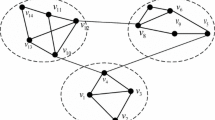Abstract
There are an extensive number of algorithms for detecting communities in networks. Modularity maximization technics are the most popular community detection methods. Despite the fact that the modularity measure is the best indicator of the partition quality, it has been proved that such technics suffer from many drawbacks: systematically merging small groups to form larger ones, the tendency to split large and dense groups and the partition of random networks where no community structures exist. In this paper we propose core expansion, a new community detection method that allows to detect communities independently from modularity. The number of communities and their members are discovered without computing the modularity score. We automatically detect the core of each possible community in the network. Then, we iteratively expand each core by adding the nodes to form the final communities. The expansion process is based on the neighborhood overlap measure. Experiments performed on real existing networks proved the performance of our algorithm: Large and dense groups are no more split and almost no communities are discovered in random networks.









Similar content being viewed by others
Explore related subjects
Discover the latest articles and news from researchers in related subjects, suggested using machine learning.Notes
www-personal.umich.edu/ ~ mejn/netdata/polbooks.zip.
References
Asmi K, Lotfi D, El Marraki M (2017) Large-scale community detection based on a new dissimilarity measure. Soc Netw Anal Min 7(1):17
Azaouzi M, Rhouma D, Romdhane LB (2019) Community detection in large-scale social networks: state-of-the-art and future directions. Soc Netw Anal Min 9(1):23
Blondel VD, Guillaume JL, Lambiotte R, Lefebvre E (2008) Fast unfolding of communities in large networks. J Stat Mech Theory Exp 2008(10):P10008
Brandes U, Delling D, Gaertler M, Görke R, Hoefer M, Nikoloski Z, Wagner D (2006) Maximizing modularity is hard. arXiv:physics/0608255
Clauset A, Newman ME, Moore C (2004) Finding community structure in very large networks. Phys Rev E 70(6):066111
Cordeiro M, Sarmento RP, Gama J (2016) Dynamic community detection in evolving networks using locality modularity optimization. Soc Netw Anal Min 6(1):15
De Meo P, Ferrara E, Fiumara G, Provetti A (2012) On Facebook, most ties are weak. arXiv:1203.0535a
Derényi I, Palla G, Vicsek T (2005) Clique percolation in random networks. Phys Rev Lett 94(16):160202
Fortunato S (2010) Community detection in graphs. Phys Rep 486(3–5):75–174
Fortunato S, Barthelemy M (2007) Resolution limit in community detection. Proc Natl Acad Sci 104(1):36–41
Girvan M, Newman ME (2002) Community structure in social and biological networks. Proc Natl Acad Sci 99(12):7821–7826
Kleinberg J, Easley D (2010) Networks, crowds, and markets: reasoning about a highly connected world. Significance 1(2):3
Knuth DE (1993) The Stanford GraphBase: a platform for combinatorial computing. AcM Press, New York, pp 74–87
Lancichinetti A, Fortunato S (2011) Limits of modularity maximization in community detection. Phys Rev E 84(6):066122
Leskovec J, Mcauley JJ (2012) Learning to discover social circles in ego networks. In: Advances in neural information processing systems, pp 539–547
Lusseau D, Schneider K, Boisseau OJ, Haase P, Slooten E, Dawson SM (2003) The bottlenose dolphin community of Doubtful Sound features a large proportion of long-lasting associations. Behav Ecol Sociobiol 54(4):396–405
Maier BF, Brockmann D (2017) Cover time for random walks on arbitrary complex networks. Phys Rev E 96(4):042307
Mattie H, Onnela JP (2017) Generalizations of edge overlap to weighted and directed networks. arXiv:1712.07110
McDaid AF, Greene D, Hurley N (2011) Normalized mutual information to evaluate overlapping community finding algorithms. arXiv:1110.2515
Meghanathan N (2016) A greedy algorithm for neighborhood overlap-based community detection. Algorithms 9(1):8
Newman ME (2004) Fast algorithm for detecting community structure in networks. Phys Rev E 69(6):066133
Newman ME (2006) Modularity and community structure in networks. Proc Natl Acad Sci 103(23):8577–8582
Pizzuti C (2009) Overlapped community detection in complex networks. In: Proceedings of the 11th annual conference on genetic and evolutionary computation. ACM, pp 859–866
Schülke C, Ricci-Tersenghi F (2015) Multiple phases in modularity-based community detection. Phys Rev E 92(4):042804
Yang J, Leskovec J (2015) Defining and evaluating network communities based on ground-truth. Knowl Inf Syst 42(1):181–213
Zachary WW (1977) An information flow model for conflict and fission in small groups. J Anthropol Res 33(4):452–473
Author information
Authors and Affiliations
Corresponding author
Additional information
Publisher's Note
Springer Nature remains neutral with regard to jurisdictional claims in published maps and institutional affiliations.
Ali Awada: Deceased March 21, 2019.
Electronic supplementary material
Below is the link to the electronic supplementary material.
Rights and permissions
About this article
Cite this article
Choumane, A., Awada, A. & Harkous, A. Core expansion: a new community detection algorithm based on neighborhood overlap. Soc. Netw. Anal. Min. 10, 30 (2020). https://doi.org/10.1007/s13278-020-00647-6
Received:
Revised:
Accepted:
Published:
DOI: https://doi.org/10.1007/s13278-020-00647-6




